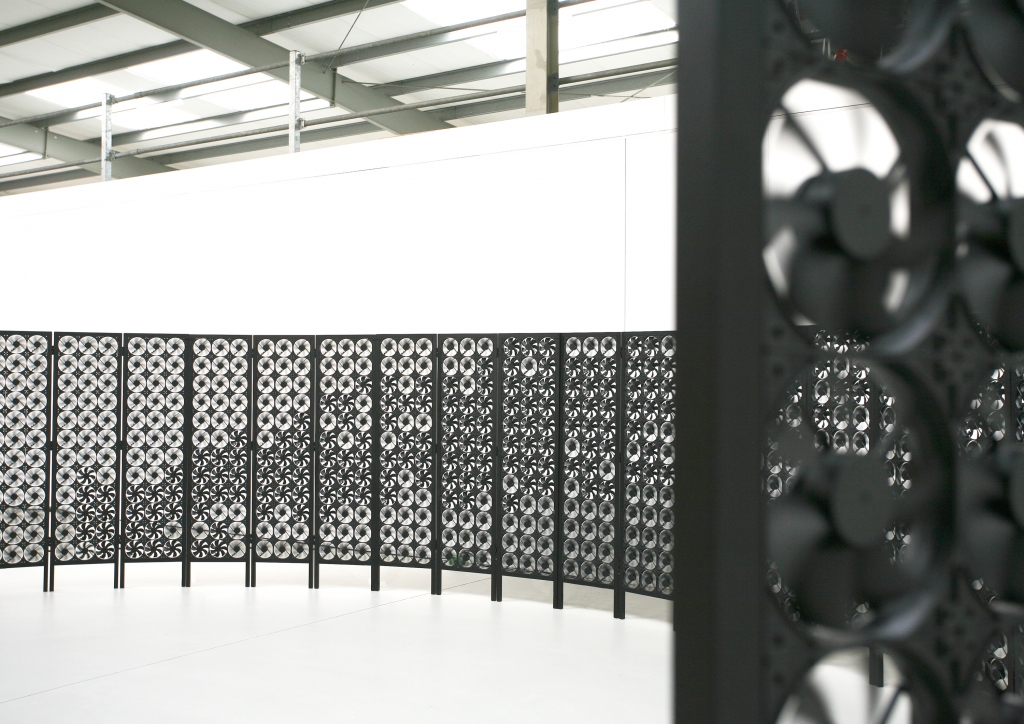Fanscreen: is comprised of several panels made up of computer fans which are linked together to form a larger ‘screen’. These screens are arranged side-by-side in a large circle that the viewer can enter. Each fan is programmed independently, creating an effect that mimics individual “pixels” on a larger screen. Moving in synchronicity, the programmed fans produce a kind of “film” of various abstract movements.
Film.
It is the passion of cinema and technology to revolutionize the perception of moving images, to establish new visual formats such as virtual as well as augmented reality, and to develop the newest technologies for the consumer at home.
An image is broadcast with an increased resolution via different devices into the living room, but the content and the related form of consumption remain completely out of question.
The studio of multidisciplinary artist Henk Stallinga explores a conceptually radical approach to this questioning. Film is no longer limited to the sequencing of individual images and the projection of light-emitting media. The abstract idea of film develops into an independent entity. The receiving sense of perception itself is challenged, as well as the actual behavior during the consumption of content.
The result is the project FANSCREEN by Henk Stallinga. Abstract film sequences are converted into a software-controlled movement of air and establish new receptive levels of perception.
The streaming air is induced and individually modulated by countless stand-alone computer fans. The molecules of the surrounding air replace the light rays as information transmitters.
A merely visual experience relies on the mechanical feedback of rotation speeds and through interference with the human eye, although the traditional form of the big screen does not exist anymore. The isolated air currents fuse into an overall frame and enable a new idea for the image.
With FANSCREEN, the inherent sovereignty of the eye as a perception portal is replaced by the skin's surface and thus a bridge between the various information channels is created.
The mechanical rotational movement of the fans, with their individual running speeds, forms superimpositions of repeating frequencies and produces moiré effects that appear to the human eye as individual images or sequences.
As the human eye can only perceive individual images up to a rate of 14-16 fps as single differentiated phenomena, everything above appears as one movement or phenomena in motion.
FANSCREEN fuses the various sensorial conditions, the individual phenomena and the de-individualized cluster which defines itself as a whole. Standstill takes place next to accelerated ecstasy, which can only be perceived as a rush. Time itself appears in the invisible and visible form of movement.
The individual elements consisting of multiple fans arranged in a large grid is positioned in a circular formation. The visitor can and is supposed to enter the spatial setting. Looking at it from the center, the single moving fans complete themselves like – a film -, into a sequential event of different abstract movements.
The visual aspect is increasingly pushed into the background by decreasing distance between audience and installation, while the perception of the airflow as the dominant impression comes to the fore.
The fans function in their individual arrangements as single segments but also form a full „screen“ as a collective. Within the installation, algorithmically generated sequences meet composed sequences. These challenge the predisposition and interpretation of patterns as perceptual phenomena.
FANSCREEN highlights the spectator's psychological tendency for selective perception in which he instinctively tends to give priority to certain aspects. This essential mechanism causes the human brain to continuously look for patterns to integrate the new information into existing ones. This is an extremely effective protective reflex that prevents the processing of stimuli against the abundance of information and enables structured processing at all.
As a result, formats and forms of information are instinctively perceived in a comparative way. There is even a psychological resonance in the evaluation itself, while similar phenomena are intensified and culminate into a higher-rated ranking. The installation establishes new neurological connections to the assessment of stimuli by the contradiction of learned inference and selectively perceived phenomena.
The receivable experience takes place beyond fixed structures and provides a new perspective on pictorial phenomena without relying on learned conventions.
What you see becomes what you experience.
Text: Thomas Schmelzer, Pylon Hub Dresden
Studio Stallinga worked over ten years to realize and amplify this installation to its current configuration. The entire installation was on view for the first time at Gerhard Hofland Gallery Amsterdam at the solo exhibition 'Animated' in September 2018. Fanscreen was exhibited at Museum Gorcum throughout 2020.

